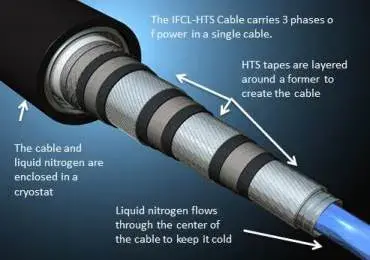Imagine a massive storm cell hits a major city in the United States, taking out a power substation leaving 20,000 people  without electricity. Even with 24-hour support, it takes days before everyone’s power returns. That’s the reality today. But what if there was a way to prevent that power outage? The Department of Homeland Security Science and Technology Directorate (S&T) has partnered with Massachusetts-based Company, AMSC, to develop a new superconductor cable – part of a Resilient Electric Grid (REG) program – that may enable urban utilities to “keep the lights on” during severe events. During a six-month feasibility study, S&T, worked with AMSC and Chicago electric utility company, Commonwealth Edison (ComEd) to determine the commercial-scale application of the superconductor cable.
without electricity. Even with 24-hour support, it takes days before everyone’s power returns. That’s the reality today. But what if there was a way to prevent that power outage? The Department of Homeland Security Science and Technology Directorate (S&T) has partnered with Massachusetts-based Company, AMSC, to develop a new superconductor cable – part of a Resilient Electric Grid (REG) program – that may enable urban utilities to “keep the lights on” during severe events. During a six-month feasibility study, S&T, worked with AMSC and Chicago electric utility company, Commonwealth Edison (ComEd) to determine the commercial-scale application of the superconductor cable.
Currently, many urban-area electrical substations aren’t connected to each other because of the amount of copper cables that would be required to move massive amounts of power as well as the risk of damaging equipment. With the existing infrastructure, if one substation loses power, all electricity in that area is lost until the substation comes back up. The primary goal of S&T’s superconductor-based Resilient Electric Grid (REG) program has been to develop and demonstrate advanced technologies to increase the reliability, flexibility and resilience of the nation’s utility grid.
By using AMSC’s inherently fault current limiting, high-temperature superconductor (IFCL-HTS) technology, companies are able to connect several substations together to mitigate or prevent disruptions. By allowing stations to share excess capacity during emergencies and reroute power as needed and share assets you reduce the likelihood of power outages for customers, explained REG Program Manager Sarah Mahmood.
Capable of carrying ten times as much power as same-size copper wires, the IFCL-HTS cable automatically adapts to power surges and disruptions and resets when conditions return to normal. A single IFCL-HTS cable can replace 12 copper cable bundles, freeing up underground space for other utility needs. This innovative solution combines two technologies, and as a result provides a new capability for resiliency by enabling multiple paths for power flow.
“I am very excited about this,” said Mahmood. “This is a potential game changer. This technology will inherently increase the resiliency, robustness and reliability of the grid.”
S&T’s REG program has three phases. During Phase One, the technology was successfully tested and demonstrated at the Oak Ridge National Laboratory in Tennessee. The fault-current-limiting capabilities of the cable were proven and the cable was qualified for installation into the nation’s electric grid.
Phase Two, in progress now, involves installing an IFCL-HTS cable in the New York City electric grid to connect two substations together in a pilot demonstration. According to Mahmood, the cable installation will be complete in 2015 and will remain operational for one year to allow S&T to assess its usability. The information gathered here will help determine how to integrate the REG into the utility sector and will inform the third phase.
In phase three, also in progress now, S&T will work with Chicago electric utility company, Commonwealth Edison (ComEd) and AMSC, to develop a detailed deployment plan for a permanent, operational installation of the technology in Chicago’s central business district. The three organizations will identify and determine solutions to any technical challenges involved with a large commercial level installation of the REG, develop a true scope, cost, and determine system risks and how to mitigate them. While this will be focused primarily on Chicago, S&T and AMSC will more broadly assess integrating the technology across the nation.
“We’re studying the different sites where we want the cable to go so we can get a handle on the engineering requirements,” said Mahmood. “After six months, we’ll have an internal review board with key subject matter experts from different agencies to review the data. Once all parties are on board and financially committed, we will move forward with the project. Should all parties agree to proceed, this commercial-scale effort could dramatically reduce the cost of the cable to the point where it would become a financially feasible technology for all utilities to consider.”
